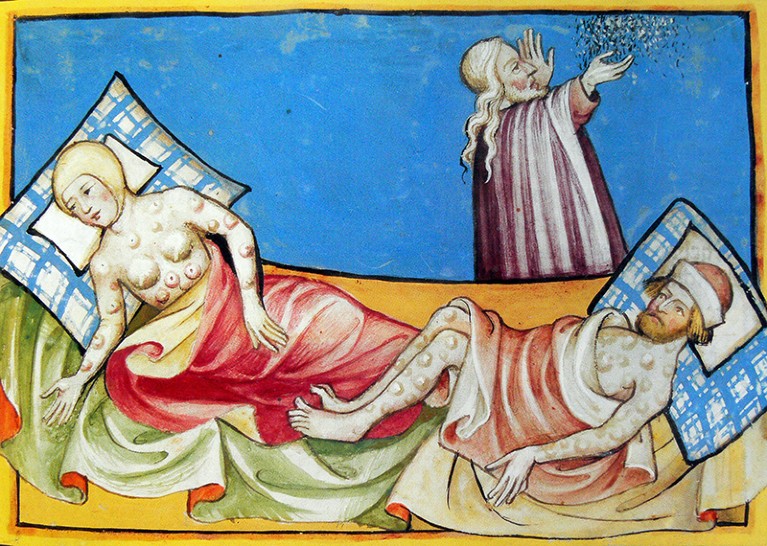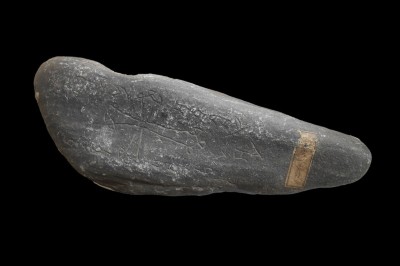[ad_1]

People with bubonic plague, such as those depicted in this fifteenth century Swiss manuscript, suffered from swollen lymph nodes.Credit: VCG Wilson/Corbis via Getty
When the Black Death swept through northern Africa and Eurasia in the mid-fourteenth century, it killed up to half of the human populations there, reshaped history — and potentially changed the course of human evolution.
A study published on 19 October in Nature1 suggests that lingering scars from the bubonic plague, which was caused by the bacterium Yersinia pestis, can be found in genes involved in the modern human immune system. Four DNA variants in particular seem to have become more common after the Black Death, and might have contributed to survival.
But the protection afforded by those variants could have come at a cost: today, two of them are associated with an increased risk of autoimmune disorders, such as Crohn’s disease and rheumatoid arthritis.
“It’s very innovative work,” says Ziyue Gao, a population geneticist at the University of Pennsylvania in Philadelphia. “We always wonder what the forces are that drive population evolution.”
Long-lasting impacts
The Black Death was the most lethal pandemic in human history, and geneticists have long been curious about its origins and its impact on human migrations and immunity. “It’s just unimaginable,” says Luis Barreiro, a human population geneticist at the University of Chicago in Illinois.
Barreiro and his colleagues hypothesized that such a dramatic event could have left its mark on the evolution of the immune system. To find out, they looked at genetic variation in more than 200 DNA samples isolated from the bones or teeth of individuals who lived before the plague, died from it or lived one or two generations later.
Ancient DNA traces origin of Black Death
The team focused on genes related to immunity and found four DNA variants that seemed to have been selected for during the Black Death in samples from both the United Kingdom and Denmark. One variant affected the expression of a gene called ERAP2. People with the variant produce a full-length version of an RNA molecule that encodes the ERAP2 protein; those who lack it make a shorter version of the RNA.
The ERAP2 protein is made by specialized immune cells called macrophages that engulf and digest bacteria. It is involved in cutting bacterial proteins into pieces, some of which are then displayed on the surface of the macrophage as a signal to other immune cells. “It’s a kind of alert system that there’s an infection going and they need to attack,” says Barreiro.
Barreiro and his collaborators speculated that having a full-length, fully functional ERAP2 protein might have improved immune protection during the Black Death. Laboratory studies backed up this idea: macrophages expressing the longer version of ERAP2 were better able to prevent Yersinia pestis replication than were macrophages expressing the truncated version.
But the protective ERAP2 gene variant is also a known risk factor for Crohn’s disease, and another of the variants Barreiro and his colleagues found is associated with rheumatoid arthritis. This, says Barreiro, highlights the relevance of studying the evolutionary pressures that might select for these variants: “These variants can also today impact sensitivity to immune-related disorders.”
Tip of the iceberg?
The team’s approach was powerful, says Johannes Krause,a palaeogeneticist at the Max Planck Institute for Evolutionary Anthropology in Leipzig, Germany, who has studied links between bubonic plague and immune-system genes. He notes that other pathogens circulating in the fourteenth century could also have led to improved survival for people with the ERAP2 variant.
Barreiro and his colleagues hope to extend their work to include more samples and more extensive DNA sequencing. This, says Gao, could reveal yet more genetic variants associated with Black Death. “I’m wondering how many variants were missed,” she says. “Does that mean they’re only detecting the tip of the iceberg?”
[ad_2]
Source link


